
Windows are an important component on how our homes and offices look and feel. They make the space open, airy, and light, which is something we all want. However, open windows can also allow strangers to see in and rooms hot and uncomfortable during the warm summer months. This might lead you to turn on the AC which will only make your energy bill go through the roof. So, what do you do?
Instead of pulling the blinds and living in the dark, modern window film technology not only lets you keep your outside views, it provides privacy and keeps your space feeling cool and comfortable. When deciding on a window film, many customers want both the heat blocking benefits of solar film and the privacy of reflective window film, but they often wonder, "does reflective window film really block the heat?"
To put it simply, yes. Reflective window film blocks a significant amount of heat, just like solar film. In fact, reflective window film provides the maximum heat rejection and Solar Art carries various kinds of reflective window film for whatever your needs are.
*Reader tip: Before we go any further, we wanted to let you know that this blog is loaded with cool window film performance statistics which we love, but we’re also window film geeks! To show the performance statistics in the simplest way to understand, we included graphs and limited the numbers. If you have any questions, please don't hesitate to comment on this blog and ask!

Want to talk more about the benefits of reflective window film?
If you aren't familiar with window film, there are a ton of heat blocking window films available that are well-known solutions for uncomfortable heat and glare. Many of Solar Art's customers come to us wanting to know how to cool their homes and offices without darkening their space or losing any outside views. All of Solar Art’s window films will block harmful UVA and UVB rays, and most of our films reduce some amount of heat and glare. The question then, is which window film will block heat the best?
If you’re looking to cool your rooms and privacy isn’t a concern, solar film is a good option. Solar film comes in a variety of different colors and shades, all of which reduce some amount of heat and glare. While solar film will help reduce heat and reduce glare in your home or office, it doesn’t provide any added privacy.
If you are looking for both privacy and cooler rooms, solar film probably isn't the answer. Reflective window film on the other hand might be. Reflective window film reduces the maximum amount of heat, as well as increases privacy. Since the title of this blog has to do with window film, you're probably interested in learning more about that, so let's continue!
Before we go even further, let’s first start by getting to know what reflective window film even is. Reflective window film is a type of window film that reflects light on the outside like a mirror, which is why it can also be known as a one-way mirror film. Reflective window film blocks people from seeing through your windows while still allowing you to see out. Meaning, it will increase privacy as well as reduce a significant amount of heat and glare.
Your next question might be, how much heat does reflective window film keep out? That’s a great question with some great answers. We’ll go into the stats for different types of reflective window films later, but for starters, all reflective window films will reduce a large amount of heat and glare.
When we compare reflective window film to solar film, keep in mind that reflective window film is darker and thus blocks more heat than standard solar film. For example, Solar Art’s one-way mirror film (RN07) blocks the most heat, light, and glare. As we’ll see later, darker and more reflective tints offer greater heat rejection than lighter tints across the board.
Like we said earlier, reflective window film reflects the outside daytime light to whoever is looking at your windows. Reflective window film offers increased privacy while also reducing heat. Our reflective window films keep more than 99% of that nasty UV radiation outside, protecting your belongings from sun-fading and harmful sun rays. The one downside is that reflective window film only gives you privacy during the day--the outside light must be brighter than the light inside.
Window film manufacturer, Llumar, describes reflective window film as "technology on two sides, this reflective window film provides a high level of heat, glare and UV control that keeps people at ease in any area. Gives a uniform and contemporary look. Looks reflective looking out as well.” Let’s dig into some of our most popular reflective window films!
Click here to get a free, no obligation consultation
If you want a reflective window film, then you have lots of options. Here's where the numbers and charts come in...so get ready. Don't worry, it won't be that bad!
Window film products have a lot of performance statistics and to make things easier, we put those stats into a graph and compared these four films with untreated clear glass. Let’s take a look…
To make it simple, untreated glass doesn't offer much privacy or protection from the sun's light or UV rays. Over 75% of all solar energy makes it through your bare glass windows. On the other hand, our reflective window films block 99% of UV light and block nearly 50% or more of solar energy and light and glare.
One-way mirror film (RN07) is best for when you want privacy during the day without blocking your view. Unlike a lot of reflective window films, Llumar’s RN07 has a higher outside and low inside reflectivity while still blocking heat and glare. RN07 blocks up to 82% of solar energy and 93% of glare.
Llumar's silver reflective window film series is made up of R20, R35, and R50. R20 is a good compromise between maximal heat rejection, privacy, and cost. The number means that in the series, R20 lets in the least amount of light (20%) and so has the darkest reflective silver tint. It blocks more than 80% of sun glare.
R35 and R50 let in more light than R20 (here, 35% and 50% of light are let in, respectively), and so they are lighter than R20. The three films perform similarly otherwise, except in the numbers: R35 blocks 69% of glare, say, while R50 blocks 46%.
Llumar defines dual-reflective window film technology as “pairing a reflective outside-facing layer with a subtler inside-facing layer. This enables it to provide significant solar control while maintaining outside views after dark, while it looks less reflective from the interior looking out.” This means that dual-reflective window film tempers reflective window film’s interior night-time reflection, so you can see more outside when it’s dark.
For this blog, we’ll talk about the three most common dual-reflective films we offer: DR 15, DRN 25, and DRN 35. They all come in the pleasing shade of warm grey. Again, remember that 15 means the film let’s 15% of light, while 35 lets in 35% of light.
Let’s look at another graph of those films’ stats against the untreated glass (which has the same stats as the previous graph!)
As you can see, dual-reflective window film performs similarly to reflective window film, except they let more light in. The three dual-reflective film difference is that the DR15 provides the most heat rejection, while DR 35 provides the least of the three. Otherwise, they all block 99% of more of UV light, all improve your home or building’s windows’ look, and all reduce hot and cold spots by insulating your windows. They’re also all durable and scratch-resistant for easy cleaning.
Exterior window film is a durable film built especially to withstand the elements outside (whereas most other window films are installed on the inside of your windows). Exterior window film offers the same heat blocking and privacy benefits and is reflective from the outside as well. Llumar’s definition describes it as possessing “impressively effective heat rejection, glare control, 99% UV ray protection.” Llumar’s exterior reflective window film has a strong, scratch-resistant coating that enables the film to stand up to the demands and exposure that are inevitable with exterior installation.
Solar Art carries many exterior window films, but we’ll look at the details for three in particular: RHE 20, RHE 35, and RHE 50. Again, the higher numbers let in more light!
We have one more graph that looks at how exterior window film compares to untreated glass (with the same specs as the other graphs).
Exterior window films perform similarly to reflective and dual-reflective window films, which is what makes window film so cool! When choosing a product, product performance is not the main concern, you just worry about the aesthetics and unique features.
All three are silver-toned. Between the three films featured here, the 20 offers the maximum amount of heat and glare reduction while the 50 offers the minimum.
Solar Art works with more than just homeowners. We work with business owners, general contractors, property managers, facility managers, and more, to install reflective window film on commercial buildings of all sizes. Glass is glass, and Solar Art’s window films work the same on both.
Now, like we said: reflective window film acts as a mirror to the outside daytime light, which means your windows will be dark on the outside. Reflective window film isn’t the first choice for homeowners as installing reflective window film changes the house’s exterior look. If your window’s outside appearance isn’t important, then a reflective window film is a great choice for you.
If you are concerned about how your home looks but still want some reflective privacy, dual-reflective window film is a great choice because it has some tint to it and looks less like a mirror. Dual reflective window film will also keep out a lot of heat. If you don’t want a reflective surface at all, then you should look at ceramic window tint instead.
Office buildings and businesses have different goals than homes, and reflective window film is common to commercial buildings. Commercial property managers often go with reflective window film because they get the maximum amount of heat rejection and privacy via mirror reflection. In the end, though, Solar Art’s window films work the same on home and commercial windows.
If you’re still not sure which reflective window film you need or want even more information, our dedicated team of window film experts will answer every question and point you toward the right film for your home’s windows. Not only do we service solar film and reflective window film, we also service decorative window film, custom graphics, anti-graffiti film, window security film, and exterior building wraps. We take pride in our work and strive for your satisfaction. Talk to us today about cooler, more private rooms!

Talk with our sales team
These Stories on Residential
Solar Art is excited to announce another acquisition with New York Window Film!
Read this postSolar Art is excited to announce another acquisition with American Window Film!
Read this postShould I tint my home windows in the winter with residential window film?
Read this postCorporate Location: 23042 Mill Creek Drive, Laguna Hills, CA 92653
Copyright 2025 - American Window Film | All Rights Reserved | Contractor's License #1054307
Comments (11)